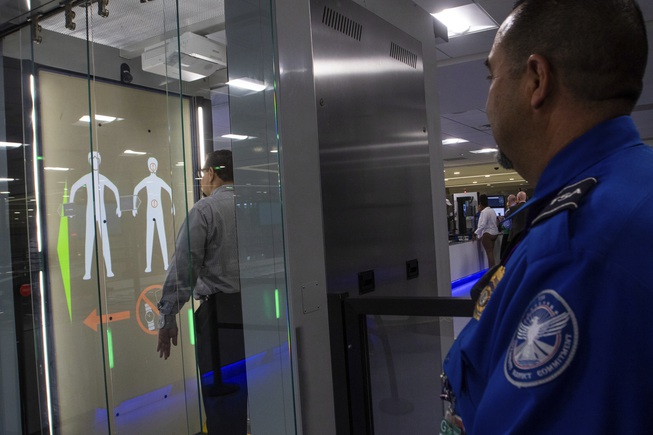
Ty O'Neil / AP
TSA officials demonstrate new screening equipment at Harry Reid International Airport, Wednesday, March 6, 2024, in Las Vegas.
Friday, March 8, 2024 | 2 a.m.
Some travelers at Harry Reid International Airport in Las Vegas will soon have a unique option for going through security.
The Transportation Security Administration unveiled a self-service screening system at Harry Reid this week that will allow passengers to go through the motions of security at their own pace, following step-by-step instructions on a video monitor with assistance from officers as needed, said Lorie Dankers, a spokesperson for TSA.
“It’s a prototype,” she said of the new technology, which will only be available to passengers with TSA PreCheck. “It’s the only one like it in the country. And it’s a system that … puts the passenger in charge of their screening experience.”
The security system was designed by TSA and the Department of Homeland Security’s Science and Technology Directorate (S&T), according to a news release, and it is the latest development out of TSA’s Innovation Checkpoint inside Harry Reid. It will be available for use later this month.
“The number of airline passengers continues to increase year-over-year, creating a need for innovative screening solutions that enhance transportation security and make traveling more efficient,” said Dimitri Kusnezov, undersecretary for science and technology at DHS in a statement. “At S&T, we are pushing the envelope with new technologies and concepts toward designing the airport of the future. Self-paced screening is one step toward building that future.”
The Innovation Checkpoint at Harry Reid initially opened in 2019 as a one-of-a-kind venue for testing new technologies — like the new self-service screening system — in a live environment. The checkpoint is on the zero level of Terminal 3 in Harry Reid, said airport spokesperson Joe Rajchel.
“If you’re talking about testing things in a live environment, we have people who come through here who are not necessarily seasoned travelers … but then we also have the convention and the business travelers who are constantly traveling,” Rajchel said. “And so to try different technologies with a mix of people to see how it works in a live environment is definitely a great thing that Las Vegas is able to offer as they test these out.”
How it works
In the self-screening process, travelers walk up and put their bag in a bin — following the instructions on a video monitor — then move to the body scanner. The scanner gives the passenger corrective feedback, Dankers said, and they have three opportunities to take the appropriate stance and get a clean scan.
If, for some reason, a passenger is unable to get a clean scan, an officer responds accordingly, she said.
Meanwhile, the system generates a 3D image of the passenger’s bag, she said, which officers in a remote location can review. The bag will either go through the scanner and immediately be picked up by its owner, automatically return to the front of the checkpoint for a rescan or be checked by a present officer, if necessary.
“So the idea is, you have less encounters with TSA officers, but they’re available to assist you if needed,” Dankers said, noting that the system will require the services of approximately eight officers, compared with 10 or 11 at a regular checkpoint.
All the policies and procedures in the self-screening line will ultimately be the same as they are in the traditional lines, Dankers emphasized, with the only difference being that TSA PreCheck travelers who opt for self-screening will go through a full body scanner, rather than a metal detector.
“If I’m a seasoned TSA PreCheck traveler, I would just say to other seasoned travelers — trust your instincts, go with what you know, follow the instructions on the on-screen monitor,” she said. “It tells you what to do.”
What to expect going forward
The prototype will open to eligible passengers by mid-March, Dankers said, kicking off a period of testing during which TSA will collect data on the performance of the screening equipment, how many travelers go through it each hour, what feedback they have and more.
Other airports have asked if they would be getting the same technology, and the answer for now is “no, not any time soon,” Dankers said. It could be several months before the technology expands, she said, as TSA learns where it may need to make changes and modifications.
“In things like this, when you have a new technology — a new concept — you have to keep evaluating it,” she said. “That’s definitely the stage we’re in right now.”
Rajchel said that testing the self-service screening system and other technologies that come out of the Innovation Checkpoint at Harry Reid benefit the airport, which saw a record number of passengers in 2023, when a total of 57.6 million passengers passed through, per a January release.
“We are very grateful to have this partnership with the TSA,” Rajchel said. “Their Innovation Checkpoint is the only one like this in the country, and so the fact that people get to come to Las Vegas and have the opportunity to test these new technologies … to be able to be there at that forefront of innovation is something that we’re grateful to continue to partner with them on.”
TSA is constantly looking at innovative ways to enhance the passenger experience, while also improving security, TSA Administrator David Pekoske said in a release.
“This self-service prototype allows our trusted travelers to complete the screening process at their own pace,” he said. “Testing at the Innovation Checkpoint in Las Vegas gives us an opportunity to collect valuable user data and insights, and explore opportunities to apply parts of the prototype to other airport security checkpoints. I am grateful for our partners in S&T and LAS airport, who were critical in bringing this vision to reality.”
[email protected] / 702-990-8926 / @_katieann13_
